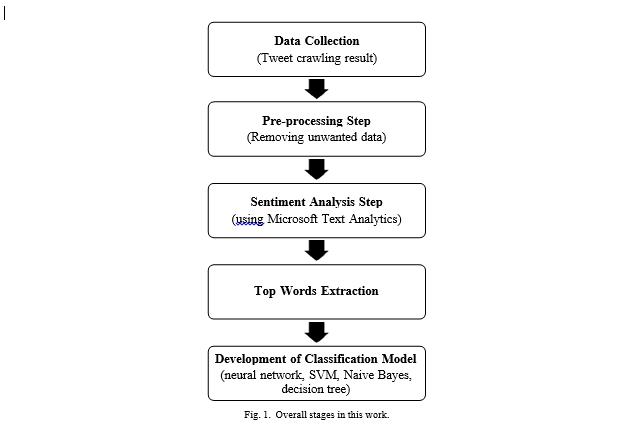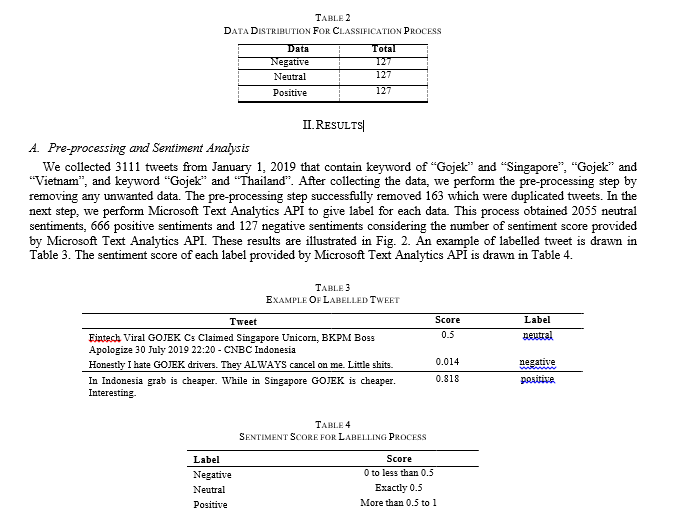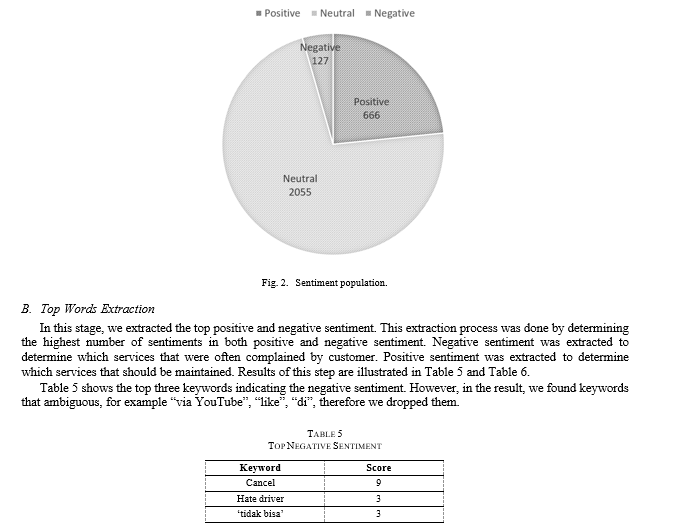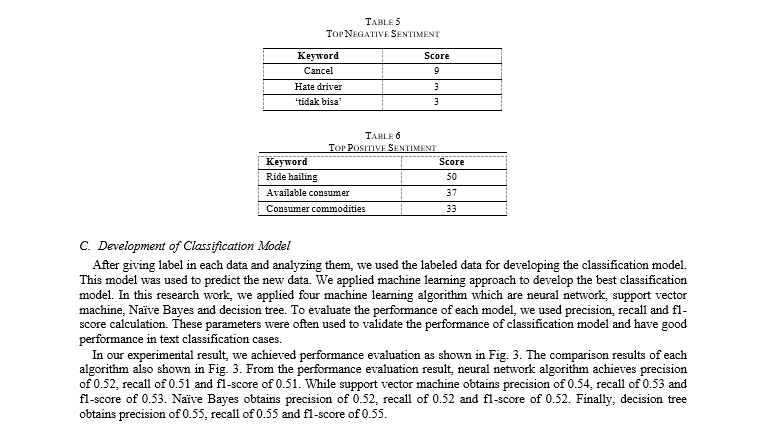Question
Sentiment Analysis for Customer Review: Case Study of GO-JEK Expansion Abstract Background: Market prediction is an important thing that needs to be analyzed deeply. Business
Sentiment Analysis for Customer Review: Case Study of GO-JEK Expansion
Abstract
Background: Market prediction is an important thing that needs to be analyzed deeply. Business intelligence becomes an important analysis procedure for analyzing the market demand and satisfaction. Since business intelligence needs a deep analysis, sentiment analysis becomes a powerful algorithm for analyzing customer review regarding to the business intelligence analysis.
Objective: In this study, we perform a sentiment analysis for identifying the business intelligence analysis in GO-JEK.
Methods: We use Twitter posts collected from the Twint library which consists of 3111 tweets. Since the dataset did not provide a ground truth, we perform Microsoft Text Analytic for determining positive, neutral, and negative sentiment. Before applying Microsoft Text Analytic, we conduct a pre-processing step to remove the unwanted data such as duplicate tweets, image, website address, etc.
Results: According to the Microsoft Text Analytic, the results are 666 positive sentiment numbers, 2055 neutral sentiment numbers, and 127 negative sentiment numbers.
Conclusion: According to these results, we conclude that most GO-JEK customers are satisfied with the GO-JEK services. In this research, we also develop classification model to predict the sentiment analysis of new data. We use some classifier algorithms such as Decision Tree, Nave Bayes, Support Vector Machine and Neural Network. In the result, the system shows that the decision tree provides the best performance.
I.NTRODUCTION
Predicting market demand and customer satisfaction requires an extensive market research to predict the market demand and customer satisfaction. Agile software development (ASD) published for helping engineer in business management problem, has been modified by applying it in the business intelligence field for producing the fast analytics in data science. Recently, business intelligence known as BI has become an important analytical procedure for analyzing market demand and satisfaction. BI is related as a technology used to analyze the business data regarding to the decision making process based on prediction analysis and provided the data enhancement process followed by an analytical technology which is widely used in several aspects such as market intelligence, e-commerce, e-health etc. [1, 2]. Currently, researchers have been accomplishing studies and concluding that BI affords two things which are process and product. Process defines as a procedure that is used to produce the important information regarding the business process. Product defines as information about empowering organizations to predict the service, customer satisfaction, competitor, marketplace, technology, etc. These two important things become a necessary part in market research and have a powerful analysis result to predict the market demand and customer satisfaction [1, 3].
Regardless of enthusiasm in the advantages of BI, conducting the BI analysis process needs a deep analysis. Sentiment analysis is one of approaches that is widely used to support the BI analysis process. Sentiment analysis is defined as a text data analysis that provides a deep analysis about sentiments, opinions, even expressed emotions and it allows us to predict the chances regarding to the analysis result.
Sentiment analysis is widely used in several cases, particularly in the review analytics cases, for example, in the analysis of praise and complaint sentences. According to the previous study, praise sentences indicate a positive subset which consists of adjectives, intensifiers, etc. Meanwhile, the complaint sentences showed a negative subset. However, in the real world, praise and complaint sentences have been delivered in the complex form. Hence, a deep analysis such as sentiment analysis may help to resolve this problem [5]. Other cases, sentiment analysis also successfully gives an effective recommendation in analyzing the customer review about airport services [6, 7, 8]. Sentiment analysis also has a powerful performance for giving recommendation on travel destination [9, 10, 11, 12, 13, 14]. Considering these facts, it can be concluded that sentiment analysis is suitable for giving recommendation and it may also give a suitable result in predictive analytics for business intelligence. Despite the powerful performance of sentiment analysis, the complexity of data also should be considered. Twitter posts are one of sentiment data that have high complexity and widely used for sentiment analysis. Twitter is a social media that is often used to share information, news and opinions. Previous study has reported the number of Twitter user is rapidly growth up in the last decade which turned into a popular media to express the public opinions.
In this study, a business intelligence based on customer review analytics was proposed to investigate and analyze the business solution in GO-JEK application case. We want to analyze the performance of sentiment analysis in evaluating customer satisfaction with GO-JEK services. We also want to know how the customer review to the GO- JEK services and want to evaluate what the services that are satisfied enough and what the services that need to be improved. In the business process, these analyses might become a suggestion for improving the services. Hence, conducting sentiment analysis to evaluate the GO-JEK is important for the business process.
GO-JEK was chosen because several countries were against GO-JEK to be operated in their countries such as Malaysia. Several opinions, reactions and perceptions are popped up about this case. Hence, we performed predictive analytics for business intelligence based on customer reviews in order to analyze how the GO-JEK customer responses about their services and to investigate the chance of GO-JEK to be operated in Malaysia. For the dataset, we use Twitter posts considering the trend of Twitter usage for expressing public opinions.
To address these research gaps, we presented a sentiment analysis on the customer review collected by Twitter posts. To handle sentiment classification task, we can use available commercial cloud services tools. Some cloud services that have been employed by other researchers are Amazon Web Service [16, 17], IBM Cloud [16], Google Cloud Platform [16] and Microsoft Text Analytics [16, 18, 19]. However, Arijit and William in [18] found that Microsoft Text Analytics was 10-20% better in identifying positive and negative sentiment when evaluated in various tweet datasets. Furthermore, Qaisi and Aljarah wrote that Microsoft could benefit from Twitter page by growing promotion offers to the customers to enhance their loyalty and satisfaction [19]. Therefore, according to the evidence stated by previous works, we performed Microsoft Text Analytics for making a ground truth data. Moreover, machine learning classifiers were approached for predicting the customer satisfaction analysis. We also analyzed the business process according to sentiment analysis result for making market decision and increasing the services.
I.METHODS
This research is conducted in four processes as depicted in Fig. 1. These all steps are described in the following subsection.
A.Dataset
In this study we used Twitter posts collected from the Twint library. Data collection was done by mining data using the following rules:
1.Twitter posts are filtered only in the countries that allows GO-JEK to operate such as Singapore, Thailand and Vietnam.
2.Twitter posts are collected since January 1, 2019.
3.All Twitter posts that contains of GOJEK tweeted by the Twitter users in Singapore, Thailand and Vietnam.
4.All Twitter posts that contains both "GOJEK" and "Singapore" keywords.
5.All Twitter posts that contains both "GOJEK" and "Thailand" keywords.
6.All Twitter posts that contains both "GOJEK" and "Vietnam" keywords. According to rules above, we got the data as shown in the Table 1.






Step by Step Solution
There are 3 Steps involved in it
Step: 1

Get Instant Access to Expert-Tailored Solutions
See step-by-step solutions with expert insights and AI powered tools for academic success
Step: 2

Step: 3

Ace Your Homework with AI
Get the answers you need in no time with our AI-driven, step-by-step assistance
Get Started


